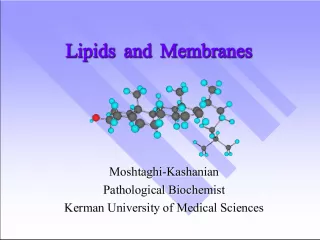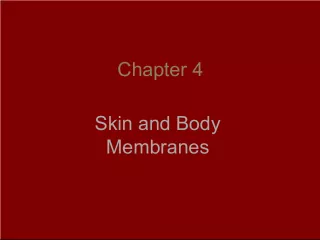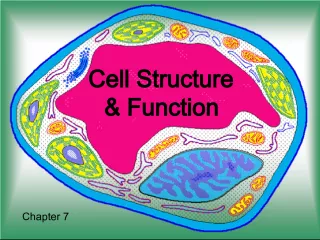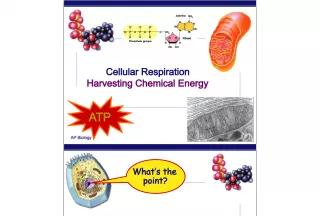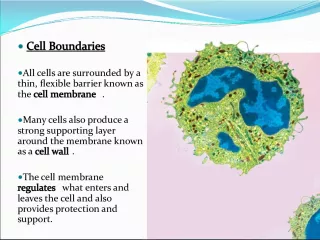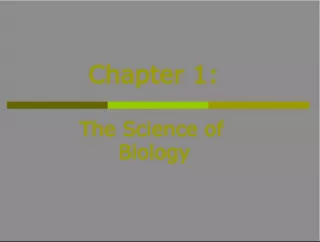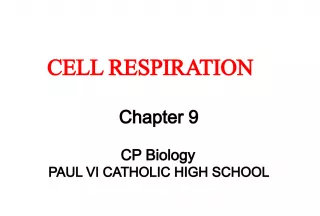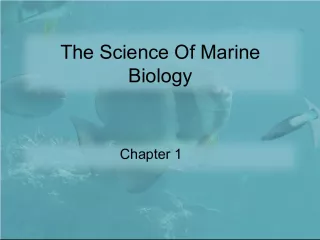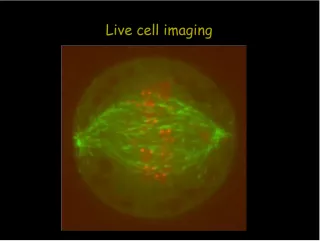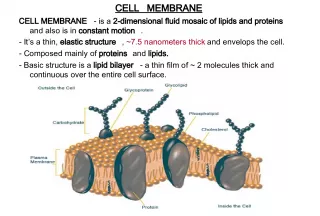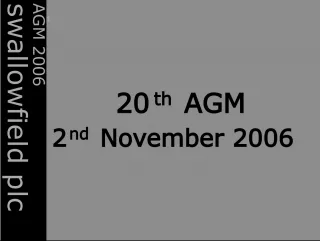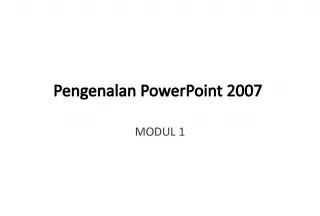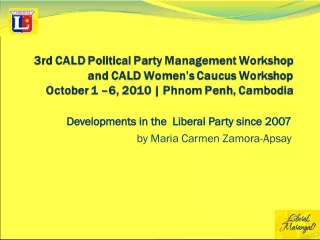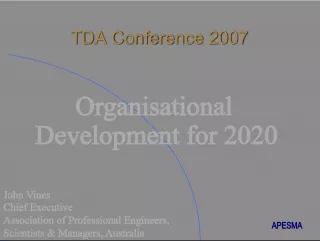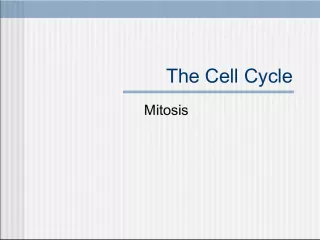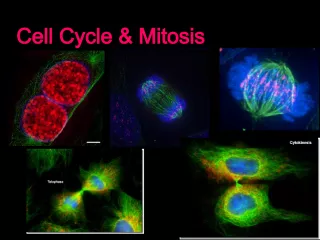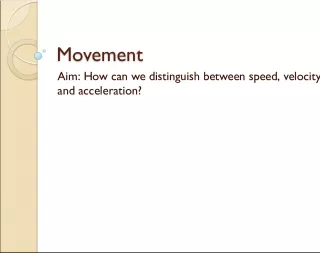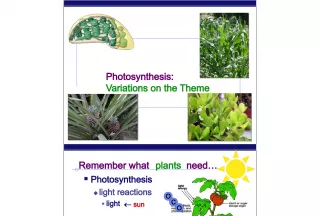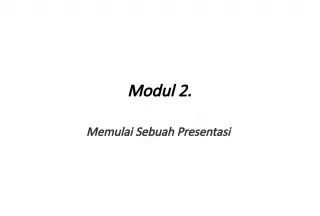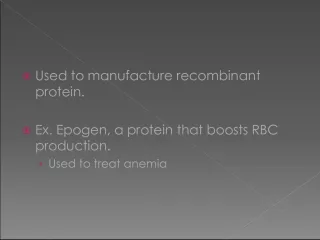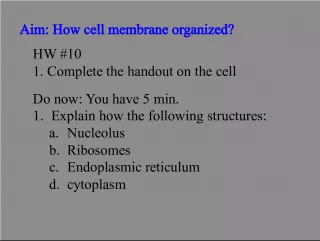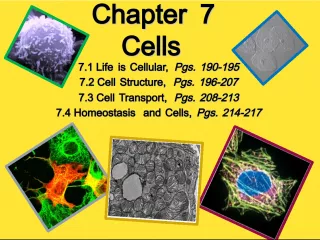Regents Biology 2006-2007: Cell Membranes and Movement Across Them
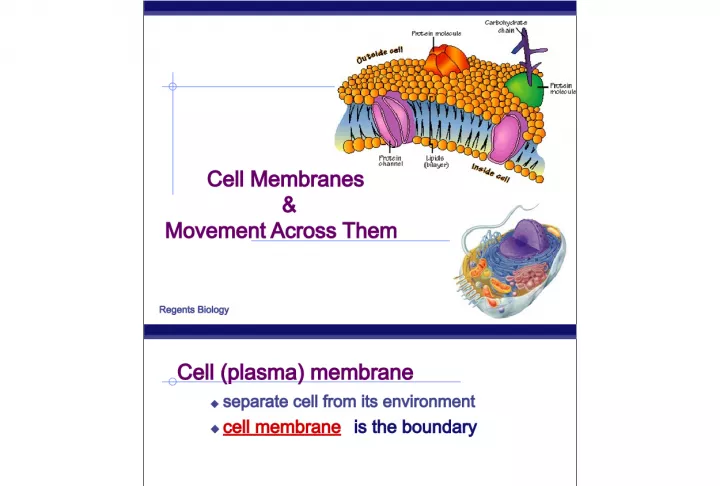

This educational resource covers the topic of cell membranes and their function in separating a cell from its environment. The cell membrane acts as a boundary between
- Uploaded on | 3 Views
-
 pratima
pratima
About Regents Biology 2006-2007: Cell Membranes and Movement Across Them
PowerPoint presentation about 'Regents Biology 2006-2007: Cell Membranes and Movement Across Them'. This presentation describes the topic on This educational resource covers the topic of cell membranes and their function in separating a cell from its environment. The cell membrane acts as a boundary between. The key topics included in this slideshow are . Download this presentation absolutely free.
Presentation Transcript
Slide1Regents Biology2006-2007 Cell Membranes & Movement Across Them
Slide2Regents BiologyCell (plasma) membrane separate cell from its environment cell membrane is the boundary IN food sugars proteins fats salts O 2 H 2 O OUT waste ammonia salts CO 2 H 2 O products cell needs materials in & products or waste out
Slide3Regents Biology
Slide4Regents Biology
Slide5Regents Biology
Slide6Regents BiologyBuilding a membrane How do you build a barrier that keeps the watery contents of the cell separate from the watery environment? What substance do you know that doesn ’ t mix with water? FATS LIPIDS oil & water don ’ t mix!!
Slide7Regents BiologyLipids of cell membrane Membrane is made of phospholipids phospholipid bilayer “ attracted to water ” “ repelled by water ” inside cell outside cell phosphate lipid
Slide8Regents BiologySemi-permeable membrane Need to allow passage through the membrane But need to control what gets in or out membrane needs to be semi-permeable So how do you build a semi-permeable membrane? So how do you build a semi-permeable membrane? aa H 2 O sugar lipid salt NH 3 So what needs to get across the membrane?
Slide9Regents BiologyPhospholipid bilayer What molecules can get through directly? *small molecules inside cell outside cell fats & other lipids can slip directly through the phospholipid cell membrane, but… what about other stuff? lipid salt aa H 2 O sugar waste
Slide10Regents BiologyPermeable cell membrane Need to allow more material through membrane needs to be permeable to… all materials a cell needs to bring in all waste a cell needs excrete out all products a cell needs to export out inside cell outside cell lipid sugar aa H 2 O salt “ holes ” , or channels , in cell membrane allow material in & out “ holes ” , or channels , in cell membrane allow material in & out waste
Slide11Regents Biologyoutside cell Semi-permeable cell membrane But the cell still needs control membrane needs to be semi-permeable specific channels allow specific material in & out inside cell sugar aa H 2 O salt waste
Slide12Regents BiologyHow do you build a semi-permeable cell membrane? channels are made of proteins proteins both “ like ” water & “ like ” lipids bi-lipid membrane protein channels in bi-lipid membrane
Slide13Regents BiologyProtein channels Proteins act as doors in the membrane channels to move specific molecules through cell membrane
Slide14Regents BiologyMost cell membranes are composed principally of 1. DNA and ATP 2. proteins and lipids 3. chitin and starch 4. nucleotides and amino acids
Slide15Regents BiologyMost cell membranes are composed principally of 1. DNA and ATP 2. proteins and lipids 3. chitin and starch 4. nucleotides and amino acids
Slide16Regents BiologyMovement through the channel Why do molecules move through membrane if you give them a channel? ? ?
Slide17Regents BiologyMolecules move from high to low Diffusion move from HIGH to LOW concentration
Slide18Regents BiologyDiffusion Move from HIGH to LOW concentration “ passive transport ” no energy needed
Slide19Regents Biology
Slide20Regents BiologySimple Diffusion Move from HIGH to LOW inside cell outside cell Which way will fat move? low high fat fat fat fat fat fat fat fat fat fat fat fat fat fat
Slide21Regents Biology
Slide22Regents BiologyDiffusion through a channel Move from HIGH to LOW inside cell outside cell sugar sugar sugar sugar sugar sugar sugar sugar sugar sugar sugar Which way will sugar move? low high sugar sugar
Slide23Regents BiologyDiffusion Move from HIGH to LOW concentration through membrane simple diffusion no energy needed through a protein channel facilitated diffusion (with help) no energy needed high low
Slide24Regents Biology
Slide25Regents BiologyActive transport Cells may need molecules to move against concentration difference need to pump “ uphill ” from LOW to HIGH using ATP protein pump requires energy ATP ATP
Slide26Regents Biology
Slide27Regents Biology
Slide28Regents BiologyTransport summary diffusion facilitated diffusion active transport ATP
Slide29Regents Biology2006-2007 Osmosis Movement of Water Across Cell Membrane
Slide30Regents BiologyOsmosis Osmosis diffusion of water from HIGH concentration of water to LOW concentration of water across a semi-permeable membrane
Slide31Regents Biology Normally, in the process of osmosis, the net flow of water molecules into or out of the cell depends upon differences in the 1. concentration of water molecules inside and outside the cell 2. concentration of enzymes on either side of the cell membrane 3. rate of molecular motion on either side of the cell membrane 4. rate of movement of insoluble molecules inside the cell
Slide32Regents BiologyKeeping water balance Cell survival depends on balancing water uptake & water loss freshwater balanced saltwater
Slide33Regents BiologyManaging water balance Balanced conditions no difference between cell & environment example : blood problem : none water flows across membrane equally, in both directions volume of cell doesn ’ t change balanced
Slide34Regents BiologyManaging water balance Freshwater a cell in fresh water example : Paramecium problem : gains water , swells & can burst water continually enters Paramecium cell solution : contractile vacuole pumps water out of cell freshwater
Slide35Regents BiologyControlling water Contractile vacuole in Paramecium
Slide36Regents BiologyManaging water balance Saltwater a cell in salt water example : shellfish problem : lose water plasmolysis in plants shrinking cell solution : take up water saltwater
Slide37Regents Biology
